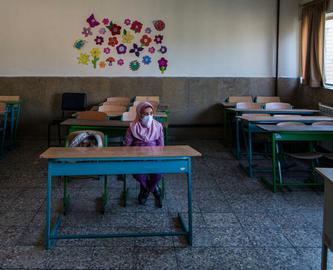A master war photographer who fled Iran in the 1980s has lamented the decline of sincere photojournalism in Iran in response to a new IranWire documentary.
Alfred Yaghobzadeh was a student during the 1979 Islamic Revolution and began his career covering street violence in Tehran in the early 1980s. He also took photos for the Associated Press and the Sigma Photo Agency during the 1980-1988 Iran-Iraq war before obtaining an exit visa and leaving the country of his birth.
IranWire’s new film, Iran’s Bloody Friday: A Photographer Remembers is set more than a decade later, but disquieting parallels can be drawn between its subject matter and Yaghobzadeh’s experience in the aftermath of the Revolution. It tells the story of Javad Montazeri and Asieh Amini: a photographer and reporter who were forced into exile over their explosive coverage of a murderous attack by security forces on the Tehran University dormitory in July 1999.
For Yaghobzadeh, the journalists’ account of persecution and harassment at the hands of the Revolutionary Guards was all too familiar. “This was happening from day one after the Revolution,” he told IranWire. “The existence of the Islamic Republic, from day one, has been based on terror.
“When I was taking photos of demonstrations in the streets, the order was ‘First shoot the press, then the protesters’. My friend got five bullets in his body at a demonstration in Tehran and spent a year in hospital. Some photographers were also executed by [the Islamic Republic’s first president] Banisadr; I visited the men in Evin Prison.”
Press freedom had been severely curtailed under the last Shah of Iran but the Islamic Revolution failed to bring about the long-sought liberalization of the Iranian media. In fact, under the auspices of the newly-formed Ministry of Culture and Islamic Guidance, Iran’s new ruling caste tightened their grip on public discourse by bringing several important newspapers such as Ettela’at and Kayhan under state control, turning them into organs for the dominant ideology, with radio and television heavily censored.
“In Iran,” Yaghobzadeh says, “the revolution was confiscated and everybody was afraid. Everybody started growing their beards and pretending they were good Muslims. And the media was out of a job. I was with AP and a local newspaper, and they raided our offices at the beginning of the war. Everybody became a ‘spy’.”
While covering gun battles in the streets between opposing political factions, and young soldiers on the frontlines of the Iran-Iraq war, Yaghobzadeh says his images were appropriated by the regime for propaganda purposes without his consent. “Some of my photos of Iran are iconic. They took my photos, without my permission, and used them to recruit young men to get killed in the war.”
When friends secured him an exit visa from Iran in 1983 to cover the conflict abroad, Yaghobzadeh says, he accepted it without hesitation and chose not to come back. “I didn’t like the ideology or the mentality,” he says. “It wasn’t hard for me to leave. It was difficult to start a new life and discover a new land, but the land is my home now.”
More than 15 years after Yaghobzadeh’s departure, Tehran was convulsed by a fresh wave of pro-democracy protests. With the election of President Mohammad Khatami came the hope for some that real reform – and with it free, impartial and rigorous journalistic practices – might be possible in Iran. But as Javad Montazeri and Asieh Amini’s testimony shows, it was not to be, and brutal suppression of honest reportage continues apace in the Islamic Republic today.
Yaghobzadeh settled in Paris and went on to work for Associated Press, Newsweek and Sipa Press, reporting on conflicts across the globe including the Lebanese civil war and Chechnya, as well as humanitarian crises and the many faces of Christianity around the world. The World Press Photo prizewinner returned to Iran for the first and only time in 2007, staying to cover the Green Movement in the wake of President Ahmadinejad’s contested re-election.
“I knew they would crush this revolution too,” he admits. “But I had young friends who were very happy and excited, and thought it was going to be like 1979. They were arrested. One of them gave my name in the Revolutionary Court and after my name was read out there, I had to go back [to Paris]. There was no other option. For this to have been the reason is really depressing.”
Now, Yaghobzadeh says, he is pessimistic about the prospects for serious journalism in Iran as all of the main agencies and outlets are directly controlled by Islamic Republic ideologues. “Political coverage is finished in Iran,” he says. “The only solution is regime change.
“Many people in Iran live with a double face on, and many photographers didn’t even go to the November 2019 protests. If I was there, I would have gone because I’m addicted to my job. But others in the Iranian press don’t because they’re afraid to be recognised and arrested. I want to know, where are the young photographers now? Where is their energy? I want to see this level of fight again.”
Related coverage:
Iran's Bloody Friday: An IranWire Film
"These Photos Belong to History": Exiled Journalist Remembers the Tehran University Siege
Photojournalist: Iran's Photographers are Forced to Work in Secret
visit the accountability section
In this section of Iran Wire, you can contact the officials and launch your campaign for various problems



























comments